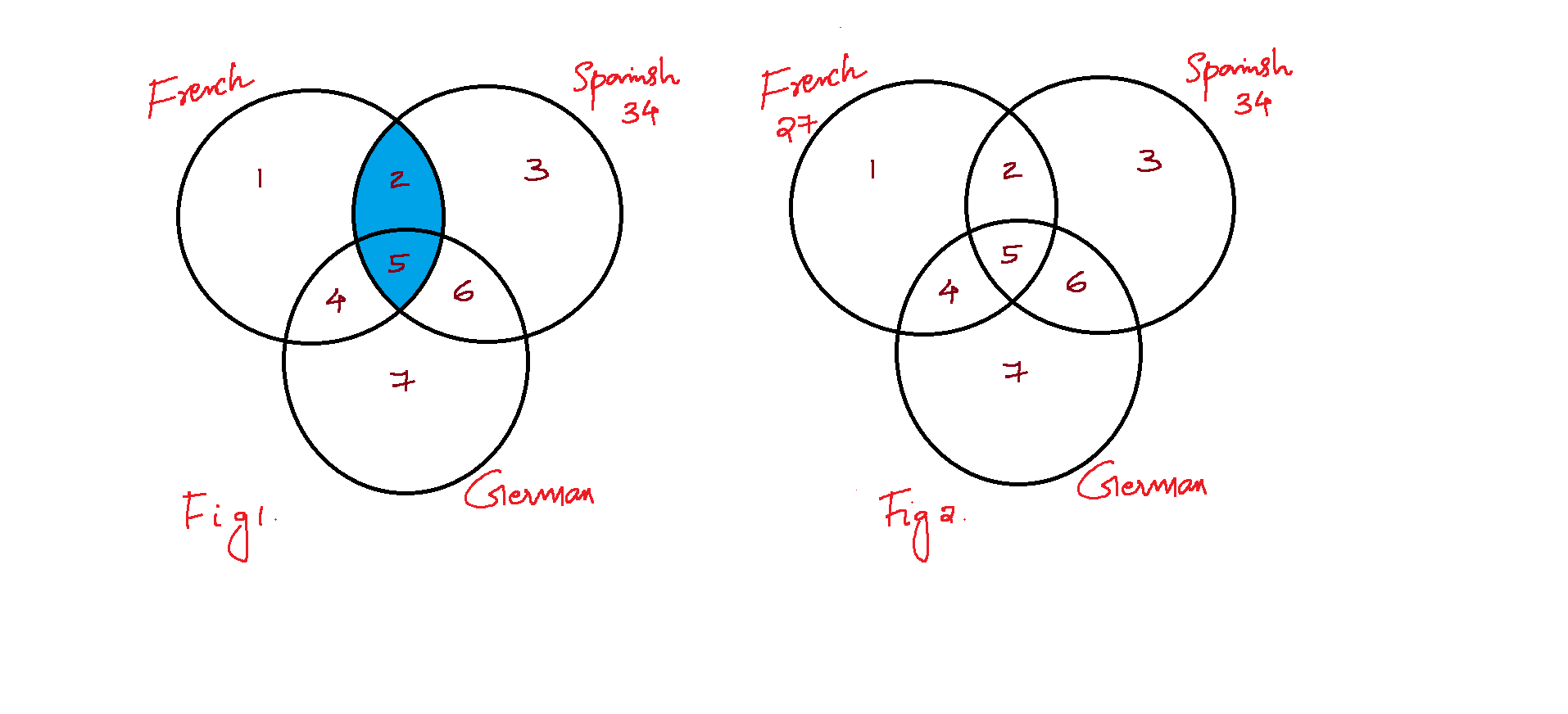CrushTHYGMAT wrote:
Hi,
avigutman BrentGMATPrepNow,
CrackVerbal, can you please help us understand what all regions 49 includes?
My understanding is that 49 includes only F + Only S + Both F&S + Both F&G + Both S&G + All three. In the context of the question, 49 should also include Both F&G and S&G because that way we do get either French or Spanish.
Thank you!
Let's analyze the question here.
A small School has three foreign language classes, one in French, one in Spanish, and one in German. How many of the 34 students enrolled in the Spanish class are also enrolled in the French class?
Attachment:
 sets.png [ 37.54 KiB | Viewed 20856 times ]
sets.png [ 37.54 KiB | Viewed 20856 times ]
Before moving to the explanation, how we define each region in the Venn diagram is very important.
Region 1 -Only French, 3 -Only Spanish, 7 - Only German
Region 2- Only French and Spanish, 4 - Only French and German, 6 - Only Spanish and German
Region 5 - All three - Spanish, French, and German
The number of the students enrolled in Spanish = n(Spanish ) = Region 3 + 2 + 5 + 6
The number of the students enrolled in French = n(French ) = Region 1 + 2 + 4 + 5
The number of students enrolled in both Spanish and French = Region 2 + 5
The number of students enrolled for both Spanish and German = Region 6 + 5
The number of students enrolled for both French and German = Region 4 + 5
The number of students enrolled in Spanish classes is 34 i.e n(Spanish) = 34 and we are asked to find the number of students enrolled in both Spanish and French classes i.e n ( both french and Spanish) which is represented by Region 2 + 5 in figure 1 attached.
(1)There are 27 students enrolled in the French class, and 49 students enrolled in either the French class, the Spanish class, or both of these classes.
Refer to fig 2 in the picture attached.
From St 1, it's given that n(French) = 27 and n(French U Spanish ) =
49 = Region 1 + 2 + 3 + 4 + 5 +6We already know that n(Spanish) = 34.
n(French U Spanish ) = n(French) + n(Spanish) - n ( both french and Spanish)
49 = 27 + 34 - n ( both french and Spanish)
n ( both french and Spanish) = 61 - 49 =12.
Since we get a definite answer for the Q.stem, Statement 1 alone is sufficient to answer.
(2) One-half of the students enrolled in the Spanish class are enrolled in more than one foreign language class.
We know that n(Spanish) = 34 and half of them i.e 17 enrolled in more than one foreign language class.
17 = Region 2 + 5 + 6
We are asked to find Region 2 + 5 in the Q.stem. Since we don't have any idea about region 6, Statement 2 alone is not sufficient.
I hope the explanation is clear to you and you got a clear idea about which region is represented by 49.
Thanks,
Clifin Francis,
GMAT Mentor.




 55%
(hard)
55%
(hard)
 34%
(02:38)
wrong
34%
(02:38)
wrong  based on 3300
sessions
based on 3300
sessions









